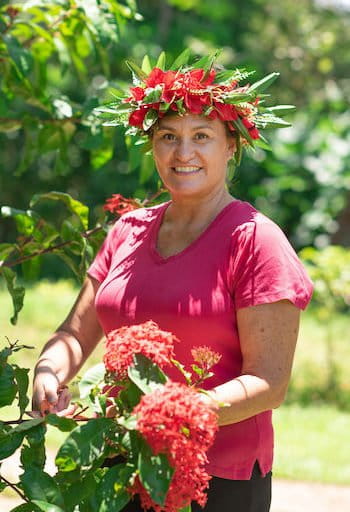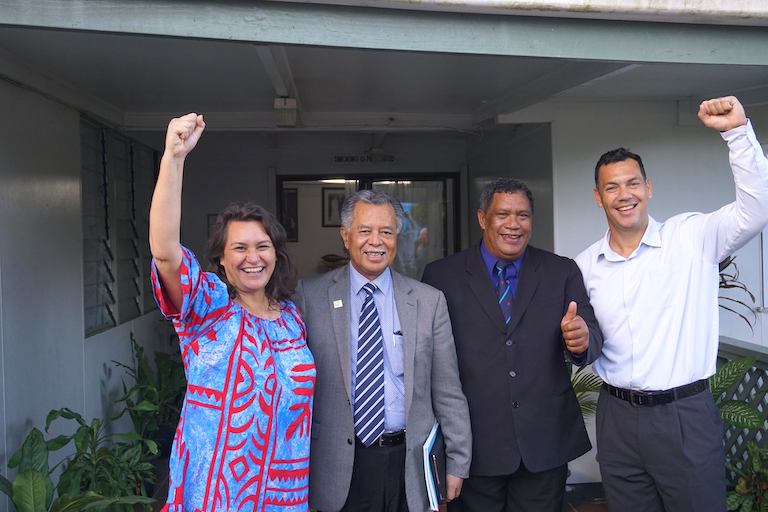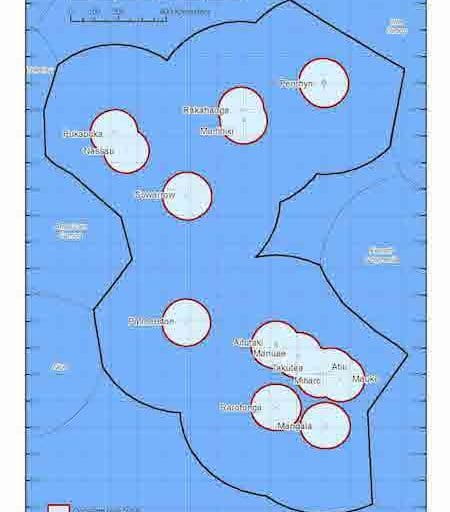- Last month the Cook Islands government dismissed the director of the world’s biggest mixed-use marine protected area (MPA), which is called Marae Moana.
- Jacqueline Evans, a marine scientist, had played a key leadership role in the seven-year campaign to establish Marae Moana and served as its director since the MPA was enshrined into law in 2017.
- Her firing came after she expressed support for a 10-year moratorium on seabed mining across the Pacific Ocean. Seabed mining has been a sticking point throughout the history of Marae Moana, with some environmentalists hoping to prohibit it outright and other parties wanting to explore it as a potential source of revenue.
- Evans was a 2019 winner of the prestigious international Goldman Prize for grassroots environmentalists in recognition of her work to make Marae Moana a reality.
This story is part of a series on Marae Moana, the massive, recently enacted multiple-use marine protected area covering the Cook Islands’ entire exclusive economic zone. Other stories in the series:
Building the world’s biggest MPA: Q&A with Goldman winner Jacqueline Evans
Will a massive marine protected area safeguard Cook Islands’ ocean?
Paradise, polluted: Cook Islands tries to clean up its tourism sector
Give it back to the gods: Reviving Māori tradition to protect marine life
For somebody who’d just been fired from a prestigious government post, Jacqueline Evans sounded remarkably upbeat. “I knew it was going to come,” she laughed during a phone interview with Mongabay. “I was surprised about what I was being sacked over, though: it was essentially just giving my opinion.”
On Sept. 20 Evans was dismissed from her position as director of the Cook Islands’ world-renowned Marae Moana marine protected area (MPA), a position she’d held since the MPA was enshrined into law in 2017. Evans, a marine scientist and 2019 winner of the prestigious international Goldman Prize for grassroots environmentalists, played a key leadership role in the seven-year campaign to establish Marae Moana, the biggest mixed-use MPA in the world at nearly 2 million square kilometers (772,200 square miles).

Ben Ponia, Prime Minister Henry Puna’s chief of staff, dismissed Evans. Evans said she’d seen it coming since Ponia, who had opposed Marae Moana since its inception, was appointed to the role a year ago. “I was kind of expecting it since he was appointed,” she said, “but I decided I was just going to stick it out and do as best as I could. And then the inevitable happened!”
Ponia has declined to comment to the media on the matter, and did not respond directly to Mongabay’s request for comment.
According to Evans, in the days prior to her firing, she advised the government via an internal email to support a 10-year moratorium on seabed mining across the entire Pacific Ocean. The Fijian prime minister, Frank Bainimarama, had called for the moratorium at the Pacific Islands Forum in Tuvalu on Aug. 13, after civil society representatives suggested it to the leaders during a dialogue. The idea was then included in a draft communiqué for an upcoming meeting of environment ministers from various Pacific island countries. That draft was circulated among Cook Islands government ministers several weeks before Evans was brought into the discussion, she said in a public statement issued on Oct. 1. The ministers expressed the view that the communiqué should omit any mention of the moratorium; Evans advised the opposite.
“I was never consulted on the position that Cook Islands would take until the very last minute, and government officials were upset that my policy advice was contrary to what they had discussed amongst themselves and that it came at a late stage,” she said in the statement. “This is a strange arrangement, considering I’m meant to be the coordinator of Marae Moana and policy advisor to the Marae Moana Council. But this behavior was consistent with what had been happening over the previous 18 months or so.”

Seabed mining has been a sticking point throughout the history of Marae Moana. While the legal act establishing the MPA was being created, some environmentalists hoped to take the possibility of allowing seabed mining off the table entirely on the grounds that it was difficult to marry with Marae Moana’s primary principle of protecting and conserving the ecological, biodiversity, and heritage values of the Cook Islands marine environment.
But many government ministers and officials were keen to pursue mining because of the potential for lucrative economic gains. Parts of the country’s sea floor are rich in manganese nodules, and the mineral is increasingly in demand globally for batteries to power technologies such as electric cars. In the end, the act only made it into law because it allowed the possibility of mining to be explored. However, the act aimed to ensure that mining could only happen in sites where it would not unduly impact deep ocean ecosystems and biodiversity.
To find out where these sites are — if indeed they exist at all — requires significant research: “10 years at least!” Evans told Mongabay. That’s why, in her view, the moratorium, “which is not a ban on exploration, but suspension of mining while data is collected by exploration and research,” would not interfere with the government’s plans.
“If they are ready within 10 years, then we know that they haven’t collected adequate data,” she said, “because you just can’t get the data that’s needed in that period of time when you’re dealing with the deep ocean.”
Evans said she believes there are also interpersonal reasons for her dismissal. “It was egos being bruised, because I was correcting them,” she said. “I wonder: is it because I’m a woman? They don’t like a woman to be questioning what they’re doing?”
She said Ponia told her that her support for the moratorium was based on emotion rather than reason. “I asked: what was emotional about putting aside mining for adequate time to collect scientific data?” she said.
Several sources also told Mongabay that Prime Minister Puna was disappointed about Evans’s receipt of the Goldman Prize in recognition of her work to make Marae Moana a reality, because he felt he deserved more credit for its creation. Despite the prestige of the $200,000 award, which is often referred to as the “Green Nobel Prize,” the Cook Islands government made no formal announcement about it at the time. Neither the prime minister’s office nor the Ministry of Foreign Affairs, which led the discussion about the Cook Islands’ position on the proposed Pacific-wide moratorium, responded to Mongabay’s requests for comment on Evans’s firing.

Maria Tuoro, who until now has been coordinating the Cook Islands component of the Ridge2Reef (R2R) program, a multi-country initiative spearheaded by the Global Environment Facility that focuses on holistic resource management and conservation, is now set to take over the Marae Moana coordination role. Tuoro’s background is in business administration.
Evans, for her part, is keen to continue to hold the government to account — from the outside this time. “I think the fact that I know what’s going on on the inside is what freaks me out the most,” she said, “but that just makes me really determined.” Alongside consultancy work, she’s also hoping to spend more time on ocean education and research.

Many locals are concerned about what Evans’s dismissal means for Marae Moana. After its marine spatial plan designating areas for particular activities is completed next year, the MPA is set to be implemented in full. “The expertise Jacqui brought to the set up of Marae Moana can not be replicated or exceeded by another,” said Teina Mackenzie, president of the local environmental NGO Te Ipukarea Society and a member of the MPA’s advisory body, the Marae Moana Council, in an email. “Her role in this initiative goes back many years, well before the Government saw merit in it and recognized it would propel the country onto the global scene.”
When the MPA was created, “it seemed too good to be true,” said Mackenzie. “Many wondered, ‘will this be another paper park?’, but the Marae Moana concept was promoted widely and with what seemed to be much genuine resolve.” However, she said, as Marae Moana moved toward implementation, transparency and genuine consultation were lacking, and some of its staunchest supporters began to lose faith.
“There are few of us that have seen the inside workings of the setup of Marae Moana and as time moves on, there is less and less belief that a multi-use protected area is really being created with conservation as the main pillar,” Mackenzie said.
For Mackenzie, Evans’s dismissal shows clearly that these concerns are justified. “These are the parameters we have been working against for years, and now the cards have been shown and no one wins in the end,” she said.
For more on the story of Marae Moana:


Banner image: An islet off Muri Beach on Rarotonga, the largest and most populous of the Cook Islands. Image by Monica Evans for Mongabay.
Monica Evans is a freelance writer based in Aotearoa New Zealand who specializes in environmental and community development issues. She has a master’s degree in development studies from Victoria University of Wellington. Find her at monicaevans.org. (She and Jacqueline Evans are not related.)
FEEDBACK: Use this form to send a message to the editor of this post. If you want to post a public comment, you can do that at the bottom of the page.
